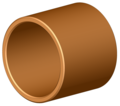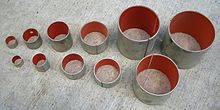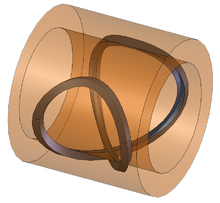Bushing introduction-a kind of slide bearings
Bushing
A bushing, also known as a bush, is an independent plain bearing that is inserted into a housing to provide a bearing surface for rotary applications; this is the most common form of a plain bearing.[6] Common designs include solid (sleeve and flanged), split, and clenched bushings. A sleeve, split, or clenched bushing is only a "sleeve" of material with an inner diameter (ID), outer diameter (OD), and length. The difference between the three types is that a solid sleeved bushing is solid all the way around, a split bushing has a cut along its length, and a clenched bearing is similar to a split bushing but with a clench across the cut. A flanged bushing is a sleeve bushing with a flange at one end extending radially outward from the OD. The flange is used to positively locate the bushing when it is installed or to provide a thrust bearing surface.[7]
Sleeve bearings of inch dimensions are almost exclusively dimensioned using the SAE numbering system. The numbering system uses the format -XXYY-ZZ, where XX is the ID in sixteenths of an inch, YY is the OD in sixteenths of an inch, and ZZ is the length in eights of an inch.[8] Metric sizes also exist.
A linear bushing is not usually pressed into a housing, but rather secured with a radial feature. Two such examples include two retaining rings, or a ring that is molded onto the OD of the bushing that matches with a groove in the housing. This is usually a more durable way to retain the bushing, because the forces acting on the bushing could press it out.
The thrust form of a bushing is conventionally called a thrust washer.
Bi-material
Bi-material bearings consist of two materials, a metal shell and a plastic bearing surface. Common combinations include a steel-backed PTFE-coated bronze and aluminum-backed Frelon.[14] Steel-backed PTFE-coated bronze bearings are rated for more load than most other bi-metal bearings and are used for rotary and oscillating motions. Aluminum-backed frelon are commonly used in corrosive environments because the Frelon is chemically inert.[15]
Bearing properties of various bi-material bearings[15]| Temperature range |
P (max.) [psi (MPa)] |
V (max.) [sfm (m/s)] |
PV (max.) [psi sfm (MPa m/s)] |
|
|---|---|---|---|---|
| Steel-backed PTFE-coated bronze | -328–536 °F or -200–280 °C | 36,000 psi or 248 MPa | 390 (2.0 m/s) | 51,000 (1.79 MPa m/s) |
| Aluminum-backed frelon | -400–400 °F or -240–204 °C | 3,000 psi or 21 MPa | 300 (1.52 m/s) | 20,000 (0.70 MPa m/s) |
Bronze
A common plain bearing design utilizes a hardened and polished steel shaft and a softer bronze bushing. The bushing is replaced whenever it has worn too much.
Common bronze alloys used for bearings include: SAE 841, SAE 660 (CDA 932), SAE 863, and CDA 954.[16]
Bearing properties of various bronze alloys[16]| Temperature range |
P (max.) [psi (MPa)] |
V (max.) [sfm (m/s)] |
PV (max.) [psi sfm (MPa m/s)] |
|
|---|---|---|---|---|
| SAE 841 | 10–220 °F (-12–104 °C) | 2,000 psi (14 MPa) | 1,200 (6.1 m/s) | 50,000 (1.75 MPa m/s) |
| SAE 660 | 10–450 °F (-12–232 °C) | 4,000 psi (28 MPa) | 750 (3.8 m/s) | 75,000 (2.63 MPa m/s) |
| SAE 863 | 10–220 °F (-12–104 °C) | 4,000 psi (28 MPa) | 225 (1.14 m/s) | 35,000 (1.23 MPa m/s) |
| CDA 954 | Less than 500 °F (260 °C) | 4,500 psi (31 MPa) | 225 (1.14 m/s) | 125,000 (4.38 MPa m/s) |
Cast iron
A cast iron bearing can be used with a hardened steel shaft because the coefficient of friction is relatively low. The cast iron glazes over therefore wear becomes negligible.[4]
Graphite
In harsh environments, such as ovens and dryers, a copper and graphite alloy, commonly known by the trademarked name graphalloy, is used. Thegraphite is a dry lubricant, therefore it is low friction and low maintenance. The copper adds strength, durability, and provides heat dissipation characteristics.
Unalloyed graphite bearings are used in special applications, such as locations that are submerged in water.[17]
Lubrication
The types of lubrication system can be categorized into three groups:[8]
- Class I — bearings that require the application of a lubricant from an external source (e.g., oil, grease, etc.).
- Class II — Bearings that contain a lubricant within the walls of the bearing (e.g., bronze, Graphite, etc.,). Typically these bearings require an outside lubricant to achieve maximum performance.
- Class III — bearings made of materials that are the lubricant. These bearings are typically considered "self-lubricating" and can run without an external lubricant.
Examples of the second type of bearing are Oilites and plastic bearings made from polyacetal; examples of the third type are metalized graphite bearings and PTFE bearings.[8]
Most plain bearings have a plain inner surface, however some are grooved. The grooves help lubrication enter the bearing and cover the whole journal.[25]
Self-lubricating plain bearings have a lubricant contained within the bearing walls. There are many forms of self-lubricating bearings. The first, and most common, are sintered metal bearings, which have porous walls. The porous walls draw oil in viacapillary action[26] and release the oil when pressure or heat is applied.[27] Another form is a solid one-piece metal bushing with a figure eightgroove channel on the inner diameter that is filled with graphite. A similar bearing replaces the figure eight groove with holes that are plugged with graphite; this allows the bearing to be lubricated inside and out.[28] The last form is a plastic bearing, which has the lubricant molded into the bearing. The lubricant is released as the bearing is run in.[29]
There are three main types of lubrication: full-film condition, boundary condition, and dry condition. Full-film conditions are when the bearing's load is carried solely by a film of fluid lubricant and there is no contact between the two bearing surfaces. In mix or boundary conditions, load is carried partly by direct surface contact and partly by a film forming between the two. In a dry condition, the full load is carried by surface-to-surface contact.
Bearings that are made from bearing grade materials always run in the dry condition. The other two classes of plain bearings can run in all three conditions; the condition in which a bearing runs is dependent on the operating conditions, load, relative surface speed, clearance within the bearing, quality and quantity of lubricant, and temperature (affecting lubricant viscosity). If the plain bearing is not designed to run in the dry or boundary condition it will wear out and have a high coefficient of friction. Dry and boundary conditions may be experienced even in a fluid bearing when operating outside of its normal operating conditions; e.g., at startup and shutdown.
- Pre:DX steel/POM bushings' catalogue 2013/8/29
- Next:Plain bearing 2013/8/28






